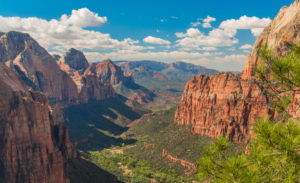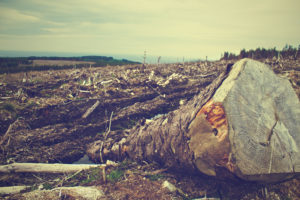The environment is usually what first comes to mind when discussing sustainability, which is why I try to get readers to think about economic and sociocultural impacts before environmental impacts. That is not to say the environment isn’t important, but I want to emphasize that in order to be sustainable it is necessary to consider ALL THREE elements. I also think the positive environmental impacts of tourism are those that are least commonly considered. So – we’ll start with the positive and end on the negative.
PRESERVATION
 The tourism industry has a serious vested interest in preserving natural resources, in most cases because it is precisely those natural resources which draw tourists to many destinations. Sun soaked beaches, coral reefs, mountain forests – some of the finest tourism attractions in the world have existed for hundreds of years with little input from human beings. Many destinations are keenly aware of this fact, and utilize a portion of tourist dollars to help maintain these areas for future tourism activities. This isn’t just limited to the shores of the Caribbean – while not ALL protected areas are designated so for the purpose of tourist consumption, it is still impressive to note that about 12% of the earth’s land mass has been designated as parks and protected areas.
The tourism industry has a serious vested interest in preserving natural resources, in most cases because it is precisely those natural resources which draw tourists to many destinations. Sun soaked beaches, coral reefs, mountain forests – some of the finest tourism attractions in the world have existed for hundreds of years with little input from human beings. Many destinations are keenly aware of this fact, and utilize a portion of tourist dollars to help maintain these areas for future tourism activities. This isn’t just limited to the shores of the Caribbean – while not ALL protected areas are designated so for the purpose of tourist consumption, it is still impressive to note that about 12% of the earth’s land mass has been designated as parks and protected areas.
EDUCATION
 One of the great things about having so many parks and protected areas across the globe is that many of them have interpretation resources. Interpretation literally means an explanation or way of explaining, and you’ve probably already experienced interpretation in a variety of ways during your travels. In the context of outdoor recreation and nature based tourism, the buildings designed to house all of the activities that educate travelers are sometimes even called interpretive centers. Other places call these buildings visitor centers, welcome centers, etc. No matter what they are called, these centers are designed to educate the traveler about the history of the area, discuss climate, geography, and provide information about the plants and animals that may be encountered. This information is invaluable to travelers as it can teach them wildlife facts that are useful in various environments and provide information on how it is appropriate and inappropriate to interact with various types of flora (plants) and fauna (animals).
One of the great things about having so many parks and protected areas across the globe is that many of them have interpretation resources. Interpretation literally means an explanation or way of explaining, and you’ve probably already experienced interpretation in a variety of ways during your travels. In the context of outdoor recreation and nature based tourism, the buildings designed to house all of the activities that educate travelers are sometimes even called interpretive centers. Other places call these buildings visitor centers, welcome centers, etc. No matter what they are called, these centers are designed to educate the traveler about the history of the area, discuss climate, geography, and provide information about the plants and animals that may be encountered. This information is invaluable to travelers as it can teach them wildlife facts that are useful in various environments and provide information on how it is appropriate and inappropriate to interact with various types of flora (plants) and fauna (animals).
DESTRUCTION
 Although tourism has progressed a great deal in terms of its relationship with the natural environment, there is still a long ways to go. There are three main ways that environmental destruction occurs in the tourism context. First, when tourism infrastructure (roads, airports, railways, etc.) and superstructure (hotels, attractions, etc.) are developed, resource use and construction waste/runoff can create a great deal of negative impacts. Certain types of tourism, like ecolodges, are specifically designed to prevent these things by using sustainably harvested local resources; however, the vast majority of new tourism developments are not done in this way. Second, the operation of tourism resources creates a great deal of waste. This is often because travelers expect a certain level of service that goes above and beyond what they normally have at home (who doesn’t like to be pampered?). To meet those expectations, the food always has to be fresh, the towels and sheets always need to be clean, and the air conditioning always has to be cold (just to name a few things). One of the biggest contributors in this area is the transportation sector, which is responsible for around 75% of the greenhouse gas emissions within the overall tourism industry. Third, the actual presence of tourists in many tourism destinations can negatively impact the environment in various ways. Vegetation can get trampled, wildlife can be stressed (Yes, animals get stressed just like you, and it can actually cause them a great deal of harm!), and things like food containers, etc. can be improperly disposed of.
Although tourism has progressed a great deal in terms of its relationship with the natural environment, there is still a long ways to go. There are three main ways that environmental destruction occurs in the tourism context. First, when tourism infrastructure (roads, airports, railways, etc.) and superstructure (hotels, attractions, etc.) are developed, resource use and construction waste/runoff can create a great deal of negative impacts. Certain types of tourism, like ecolodges, are specifically designed to prevent these things by using sustainably harvested local resources; however, the vast majority of new tourism developments are not done in this way. Second, the operation of tourism resources creates a great deal of waste. This is often because travelers expect a certain level of service that goes above and beyond what they normally have at home (who doesn’t like to be pampered?). To meet those expectations, the food always has to be fresh, the towels and sheets always need to be clean, and the air conditioning always has to be cold (just to name a few things). One of the biggest contributors in this area is the transportation sector, which is responsible for around 75% of the greenhouse gas emissions within the overall tourism industry. Third, the actual presence of tourists in many tourism destinations can negatively impact the environment in various ways. Vegetation can get trampled, wildlife can be stressed (Yes, animals get stressed just like you, and it can actually cause them a great deal of harm!), and things like food containers, etc. can be improperly disposed of.
Continue on to economic impacts or sociocultural impacts to learn more!
